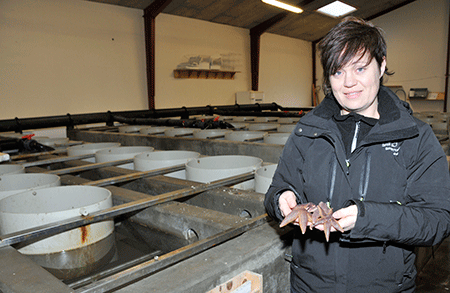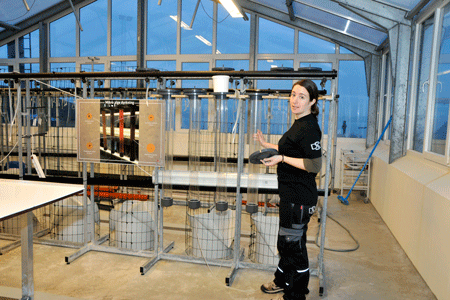The merger of the Danish Shellfish Centre in Limfjord and DTU Aqua unifies much of the country’s shellfish and seaweed expertise.
DTU Aqua’s new Shellfish Centre is alive with the sound of creeping, crawling, gurgling shellfish. Here are long rows of vats containing lobsters of all sizes—from tiny black dots to massive creatures with giant claws. Here are bubbling basins full of mother oysters, which will soon produce more than a million eggs. In a third room, we find long rows of flasks and glass containers; this is where microalgae are cultivated to feed the multitude of oyster young.
 |
|
Biologist Ditte Tørring from DTU Aqua’s new Shellfish Centre with a handful of Limfjord starfish.
Photo: Tine Kortenbach
|
 |
|
Laboratory Technician Mafalda Guilherme prepares the special diet of algae on which oyster young feed.
Photo: Tine Kortenbach
|
The centre is devoted to research and innovation in the sustainable exploitation of coastal zone resources with particular focus on shellfish. Employing 15-16 members of staff, the centre is now an integrated part of DTU Aqua.
“We are delighted to be part of a larger academic environment and look forward to professional sparring with our colleagues in Charlottenlund, Hirtshals and Silkeborg. It will undoubtedly spur us on to greater things,” says the centre’s former CEO, Jens Kjerulf Petersen, who now answers to the title of Head of Centre.
He is also looking forward to drawing on a research application support system. The centre was established in 2002 as an industrial foundation devoted to promoting sustainable farming, fishing and industrial processing of shellfish. However, in the wake of recent years’ university reforms, it has become extremely difficult for a business to drive profitable research.
The centre also has a communication brief—Morsø Secondary School, local elementary schools and tourists are among the many annual visitors to the centre, which is situated next to the harbour in Nykøbing on the island of Mors in Limfjord.
New to teaching
“Teaching at DTU will be something new for us. We’re a little off the beaten track so we hope that the merger will draw more students to the area,” adds Jens Kjerulf Petersen.
Management at DTU Aqua is also looking forward to working with its new colleagues. As Vice Director at DTU Aqua, Eskild Kirkegaard was responsible for implementing the merger.
“We complement each other well. We are now able to unify much of the country’s shellfish and seaweed expertise. This will strengthen DTU’s research and innovation as well as the university’s research-based consultancy of public authorities,” says Eskild Kirkegaard, currently Chief Fisheries Adviser at DTU Aqua.